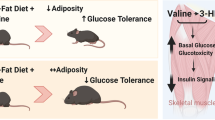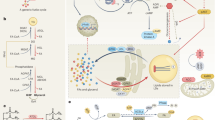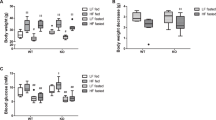Key Points
-
Long-chain acylcarnitines (LCACs) are lipid derivatives generated from carnitine by mitochondrial carnitine O-palmitoyltransferase 1 or through the reversible activity of carnitine O-palmitoyltransferase 2 on long-chain acyl-coenzyme A metabolites
-
Long-chain acyl-coenzyme A metabolites are impermeable to mitochondrial membranes; therefore, LCACs act as the fatty acid transport moieties for oxidative catabolism
-
Mutations in key enzymes increase mitochondrial and cytosolic pools of long-chain acyl-coenzyme A, promoting an accumulation of LCACs that is diagnostic of fatty acid oxidation disorders
-
LCACs can modulate inflammation, insulin sensitivity, myocyte stress, protein kinase C signalling and ion balance, which suggests that they contribute to both physiological and pathophysiological processes beyond fuel trafficking
-
A model is proposed to explain how LCACs affect disparate cell systems on the basis of their zwitterion biochemical structure and published evidence that they interact with plasma membranes
-
In this model, accumulation of LCACs is predicted to alter the activities of key receptors, transporters, channels and enzymes that associate with (or involve) plasma, mitochondrial or other membranes
Abstract
Perturbations in metabolic pathways can cause substantial increases in plasma and tissue concentrations of long-chain acylcarnitines (LCACs). For example, the levels of LCACs and other acylcarnitines rise in the blood and muscle during exercise, as changes in tissue pools of acyl-coenzyme A reflect accelerated fuel flux that is incompletely coupled to mitochondrial energy demand and capacity of the tricarboxylic acid cycle. This natural ebb and flow of acylcarnitine generation and accumulation contrasts with that of inherited fatty acid oxidation disorders (FAODs), cardiac ischaemia or type 2 diabetes mellitus. These conditions are characterized by very high (FAODs, ischaemia) or modestly increased (type 2 diabetes mellitus) tissue and blood levels of LCACs. Although specific plasma concentrations of LCACs and chain-lengths are widely used as diagnostic markers of FAODs, research into the potential effects of excessive LCAC accumulation or the roles of acylcarnitines as physiological modulators of cell metabolism is lacking. Nevertheless, a growing body of evidence has highlighted possible effects of LCACs on disparate aspects of pathophysiology, such as cardiac ischaemia outcomes, insulin sensitivity and inflammation. This Review, therefore, aims to provide a theoretical framework for the potential consequences of tissue build-up of LCACs among individuals with metabolic disorders.
This is a preview of subscription content, access via your institution
Access options
Subscribe to this journal
Receive 12 print issues and online access
$209.00 per year
only $17.42 per issue
Buy this article
- Purchase on Springer Link
- Instant access to full article PDF
Prices may be subject to local taxes which are calculated during checkout


Similar content being viewed by others
References
Reuter, S. E. & Evans, A. M. Carnitine and acylcarnitines: pharmacokinetic, pharmacological and clinical aspects. Clin. Pharmacokinet. 51, 553–572 (2012).
Rinaldo, P., Matern, D. & Bennett, M. J. Fatty acid oxidation disorders. Annu. Rev. Physiol. 64, 477–502 (2002).
Wilcken, B., Wiley, V., Hammond, J. & Carpenter, K. Screening newborns for inborn errors of metabolism by tandem mass spectrometry. N. Engl. J. Med. 348, 2304–2312 (2003).
Rocha, H. et al. Birth prevalence of fatty acid β-oxidation disorders in Iberia. JIMD Rep. 16, 89–94 (2014).
Brass, E. P. & Hoppel, C. L. Relationship between acid-soluble carnitine and coenzyme A pools in vivo. Biochem J. 190, 495–504 (1980).
Ramsay, R. R. & Zammit, V. A. Carnitine acyltransferases and their influence on CoA pools in health and disease. Mol. Aspects Med. 25, 475–493 (2004).
Eaton, S., Bartlett, K. & Pourfarzam, M. Mammalian mitochondrial β-oxidation. Biochem J. 320, 345–357 (1996).
Noland, R. C. et al. Carnitine insufficiency caused by aging and overnutrition compromises mitochondrial performance and metabolic control. J. Biol. Chem. 284, 22840–22852 (2009).
Violante, S. et al. Carnitine palmitoyltransferase 2 and carnitine/acylcarnitine translocase are involved in the mitochondrial synthesis and export of acylcarnitines. FASEB J. 27, 2039–2044 (2013).
Palmieri, F. The mitochondrial transporter family SLC25: identification, properties and physiopathology. Mol. Aspects Med. 34, 465–484 (2013).
Pochini, L., Oppedisano, F. & Indiveri, C. Reconstitution into liposomes and functional characterization of the carnitine transporter from renal cell plasma membrane. Biochim. Biophys. Acta 1661, 78–86 (2004).
Suhre, K. et al. Human metabolic individuality in biomedical and pharmaceutical research. Nature 477, 54–60 (2011).
Hediger, M. A. et al. The ABCs of solute carriers: physiological, pathological and therapeutic implications of human membrane transport proteins. Pflugers Arch. 447, 465–468 (2004).
He, L., Vasiliou, K. & Nebert, D. W. Analysis and update of the human solute carrier (SLC) gene superfamily. Hum. Genomics 3, 195–206 (2009).
Carpenter, K. H. & Wiley, V. Application of tandem mass spectrometry to biochemical genetics and newborn screening. Clin. Chim. Acta 322, 1–10 (2002).
Rinaldo, P., Cowan, T. M. & Matern, D. Acylcarnitine profile analysis. Genet. Med. 10, 151–156 (2008).
Bonnefont, J. P. et al. Carnitine palmitoyltransferase deficiencies. Mol. Genet. Metab. 68, 424–440 (1999).
Matern, D. & Rinaldo, P. in GeneReviews® (eds Pagon, R. A. et al.) Medium-chain acyl-coenzyme A dehydrogenase deficiency (University of Washington, 1993).
Spiekerkoetter, U. Mitochondrial fatty acid oxidation disorders: clinical presentation of long-chain fatty acid oxidation defects before and after newborn screening. J. Inherit. Metab. Dis. 33, 527–532 (2010).
Stanley, C. A. et al. A deficiency of carnitine–acylcarnitine translocase in the inner mitochondrial membrane. N. Engl. J. Med. 327, 19–23 (1992).
Schiff, M. et al. Molecular and cellular pathology of very-long-chain acyl-CoA dehydrogenase deficiency. Mol. Genet. Metab. 109, 21–27 (2013).
Rector, R. S., Payne, R. M. & Ibdah, J. A. Mitochondrial trifunctional protein defects: clinical implications and therapeutic approaches. Adv. Drug Deliv. Rev. 60, 1488–1496 (2008).
Isackson, P. J. et al. CPT2 gene mutations resulting in lethal neonatal or severe infantile carnitine palmitoyltransferase II deficiency. Mol. Genet. Metab. 94, 422–427 (2008).
McHugh, D. et al. Clinical validation of cutoff target ranges in newborn screening of metabolic disorders by tandem mass spectrometry: a worldwide collaborative project. Genet. Med. 13, 230–254 (2011).
Pollitt, R. J. Disorders of mitochondrial long-chain fatty acid oxidation. J. Inherit. Metab. Dis. 18, 473–490 (1995).
Gillingham, M. B. et al. Optimal dietary therapy of long-chain 3-hydroxyacyl-CoA dehydrogenase deficiency. Mol. Genet. Metab. 79, 114–123 (2003).
Schiff, M., Bénit, P., Jacobs, H. T., Vockley, J. & Rustin, P. Therapies in inborn errors of oxidative metabolism. Trends Endocrinol. Metab. 23, 488–495 (2012).
Knabb, M. T., Saffitz, J. E., Corr, P. B. & Sobel, B. E. The dependence of electrophysiological derangements on accumulation of endogenous long-chain acyl carnitine in hypoxic neonatal rat myocytes. Circ. Res. 58, 230–240 (1986).
Sato, T., Kiyosue, T. & Arita, M. Inhibitory effects of palmitoylcarnitine and lysophosphatidylcholine on the sodium current of cardiac ventricular cells. Pflugers Arch. 420, 94–100 (1992).
Aguer, C. et al. Acylcarnitines: potential implications for skeletal muscle insulin resistance. FASEB J. 29, 336–345 (2015).
Rutkowsky, J. M. et al. Acylcarnitines activate proinflammatory signaling pathways. Am. J. Physiol. Endocrinol. Metab. 306, E1378–E1387 (2014).
McCoin, C. S., Knotts, T. A., Ono-Moore, K. D., Oort, P. J. & Adams, S. H. Long-chain acylcarnitines activate cell stress and myokine release in C2C12 myotubes: calcium-dependent and -independent effects. Am. J. Physiol. Endocrinol. Metab. 308, E990–E1000 (2015).
Sobiesiak-Mirska, J. & A. Nałecz, K. Palmitoylcarnitine modulates interaction between protein kinase C βII and its receptor RACK1. FEBS J. 273, 1300–1311 (2006).
Lopaschuk, G. D., Ussher, J. R., Folmes, C. D., Jaswal, J. S. & Stanley, W. C. Myocardial fatty acid metabolism in health and disease. Physiol. Rev. 90, 207–258 (2010).
Lopaschuk, G. D., Wall, S. R., Olley, P. M. & Davies, N. J. Etomoxir, a carnitine palmitoyltransferase I inhibitor, protects hearts from fatty acid-induced ischemic injury independent of changes in long chain acylcarnitine. Circ. Res. 63, 1036–1043 (1988).
Heathers, G. P., Yamada, K. A., Kanter, E. M. & Corr, P. B. Long-chain acylcarnitines mediate the hypoxia-induced increase in α1-adrenergic receptors on adult canine myocytes. Circ. Res. 61, 735–746 (1987).
Corr, P. B., Creer, M. H., Yamada, K. A., Saffitz, J. E. & Sobel, B. E. Prophylaxis of early ventricular fibrillation by inhibition of acylcarnitine accumulation. J. Clin. Invest. 83, 927–936 (1989).
Cho, K. S. & Proulx, P. Lysis of erythrocytes by long-chain acyl esters of carnitine. Biochim. Biophys. Acta 193, 30–35 (1969).
Busselen, P., Sercu, D. & Verdonck, F. Exogenous palmitoyl carnitine and membrane damage in rat hearts. J. Mol. Cell. Cardiol. 20, 905–916 (1988).
Xiao, C. Y., Chen, M., Hara, A., Hashizume, H. & Abiko, Y. Palmitoyl-L-carnitine modifies the myocardial levels of high-energy phosphates and free fatty acids. Basic Res. Cardiol. 92, 320–330 (1997).
Adams, R. J. et al. In vitro effects of palmitylcarnitine on cardiac plasma membrane Na, K-ATPase, and sarcoplasmic reticulum Ca2+-ATPase and Ca2+ transport. J. Biol. Chem. 254, 12404–12410 (1979).
Wu, J. & Corr, P. B. Palmitoylcarnitine increases [Na+]i and initiates transient inward current in adult ventricular myocytes. Am. J. Physiol. 268, H2405–H2417 (1995).
Meszaros, J. & Pappano, A. J. Electrophysiological effects of L-palmitoylcarnitine in single ventricular myocytes. Am. J. Physiol. 258, H931–H938 (1990).
Lamers, J. M., Stinis, H. T., Montfoort, A. & Hulsmann, W. C. The effect of lipid intermediates on Ca2+ and Na+ permeability and (Na+ + K+)-ATPase of cardiac sarcolemma. A possible role in myocardial ischemia. Biochim. Biophys. Acta 774, 127–137 (1984).
Yamada, K. A., Kanter, E. M. & Newatia, A. Long-chain acylcarnitine induces Ca2+ efflux from the sarcoplasmic reticulum. J. Cardiovasc. Pharmacol. 36, 14–21 (2000).
Wood, J. M., Bush, B., Pitts, B. J. & Schwartz, A. Inhibition of bovine heart Na+, K+-ATPase by palmitylcarnitine and palmityl-CoA. Biochem. Biophys. Res. Commun. 74, 677–684 (1977).
el-Hayek, R., Valdivia, C., Valdivia, H. H., Hogan, K. & Coronado, R. Activation of the Ca2+ release channel of skeletal muscle sarcoplasmic reticulum by palmitoyl carnitine. Biophys. J. 65, 779–789 (1993).
Wu, J., McHowat, J., Saffitz, J. E., Yamada, K. A. & Corr, P. B. Inhibition of gap junctional conductance by long-chain acylcarnitines and their preferential accumulation in junctional sarcolemma during hypoxia. Circ. Res. 72, 879–889 (1993).
Sato, T., Arita, M. & Kiyosue, T. Differential mechanism of block of palmitoyl lysophosphatidylcholine and of palmitoylcarnitine on inward rectifier K+ channels of guinea-pig ventricular myocytes. Cardiovasc. Drugs Ther. 7 (Suppl. 3), 575–584 (1993).
Ferro, F. et al. Long-chain acylcarnitines regulate the hERG channel. PLoS ONE 7, e41686 (2012).
Liu, Q. Y. & Rosenberg, R. L. Activation and inhibition of reconstituted cardiac L-type calcium channels by palmitoyl-L-carnitine. Biochem. Biophys. Res. Commun. 228, 252–258 (1996).
Wu, J. & Corr, P. B. Influence of long-chain acylcarnitines on voltage-dependent calcium current in adult ventricular myocytes. Am. J. Physiol. 263, H410–H417 (1992).
De Villiers, M. & Lochner, A. Mitochondrial Ca2+ fluxes: role of free fatty acids, acyl-CoA and acylcarnitine. Biochim Biophys Acta 876, 309–317 (1986).
Wolkowicz, P. E. & McMillin-Wood, J. Respiration-dependent calcium ion uptake by two preparations of cardiac mitochondria. Effects of palmitoyl-coenzyme A and palmitoylcarnitine on calcium ion cycling and nicotinamide nucleotide reduction state. Biochem. J. 186, 257–266 (1980).
Baydoun, A. R., Markham, A., Morgan, R. M. & Sweetman, A. J. Palmitoyl carnitine: an endogenous promotor of calcium efflux from rat heart mitochondria. Biochem Pharmacol 37, 3103–3107 (1988).
Hoppel, C. L. & Genuth, S. M. Carnitine metabolism in normal-weight and obese human subjects during fasting. Am. J. Physiol. 238, E409–E415 (1980).
Adams, S. H. et al. Plasma acylcarnitine profiles suggest incomplete long-chain fatty acid β-oxidation and altered tricarboxylic acid cycle activity in type 2 diabetic African-American women. J. Nutr. 139, 1073–1081 (2009).
Mai, M. et al. Serum levels of acylcarnitines are altered in prediabetic conditions. PLoS ONE 8, e82459 (2013).
Ha, C. Y. et al. The association of specific metabolites of lipid metabolism with markers of oxidative stress, inflammation and arterial stiffness in men with newly diagnosed type 2 diabetes. Clin. Endocrinol. (Oxf.) 76, 674–682 (2012).
Mihalik, S. J. et al. Increased levels of plasma acylcarnitines in obesity and type 2 diabetes and identification of a marker of glucolipotoxicity. Obesity (Silver Spring) 18, 1695–1700 (2010).
Koves, T. R. et al. Mitochondrial overload and incomplete fatty acid oxidation contribute to skeletal muscle insulin resistance. Cell Metab. 7, 45–56 (2008).
Muoio, D. M. & Koves, T. R. Lipid-induced metabolic dysfunction in skeletal muscle. Novartis Found Symp. 286, 24–38 (2007).
Itani, S. I., Ruderman, N. B., Schmieder, F. & Boden, G. Lipid-induced insulin resistance in human muscle is associated with changes in diacylglycerol, protein kinase C, and IκB-α. Diabetes 51, 2005–2011 (2002).
Holland, W. L. et al. Inhibition of ceramide synthesis ameliorates glucocorticoid-, saturated-fat-, and obesity-induced insulin resistance. Cell Metab. 5, 167–179 (2007).
Hotamisligil, G. S., Shargill, N. S. & Spiegelman, B. M. Adipose expression of tumor necrosis factor-α: direct role in obesity-linked insulin resistance. Science 259, 87–91 (1993).
An, J. et al. Hepatic expression of malonyl-CoA decarboxylase reverses muscle, liver and whole-animal insulin resistance. Nat. Med. 10, 268–274 (2004).
Koves, T. R. et al. Peroxisome proliferator-activated receptor-γ co-activator 1α-mediated metabolic remodeling of skeletal myocytes mimics exercise training and reverses lipid-induced mitochondrial inefficiency. J. Biol. Chem. 280, 33588–33598 (2005).
Chao, L. C. et al. Insulin resistance and altered systemic glucose metabolism in mice lacking Nur77. Diabetes 58, 2788–2796 (2009).
De Vogel-van den Bosch, J. et al. The effects of long- or medium-chain fat diets on glucose tolerance and myocellular content of lipid intermediates in rats. Obesity (Silver Spring) 19, 792–799 (2011).
Wellen, K. E. & Hotamisligil, G. S. Inflammation, stress, and diabetes. J. Clin. Invest. 115, 1111–1119 (2005).
Summers, S. A. Ceramides in insulin resistance and lipotoxicity. Prog. Lipid Res. 45, 42–72 (2006).
Erion, D. M. & Shulman, G. I. Diacylglycerol-mediated insulin resistance. Nat. Med. 16, 400–402 (2010).
Lee, J. Y., Sohn, K. H., Rhee, S. H. & Hwang, D. Saturated fatty acids, but not unsaturated fatty acids, induce the expression of cyclooxygenase-2 mediated through Toll-like receptor 4. J. Biol. Chem. 276, 16683–16689 (2001).
Lee, J. Y. et al. Saturated fatty acid activates but polyunsaturated fatty acid inhibits Toll-like receptor 2 dimerized with Toll-like receptor 6 or 1. J. Biol. Chem. 279, 16971–16979 (2004).
Wong, S. W. et al. Fatty acids modulate Toll-like receptor 4 activation through regulation of receptor dimerization and recruitment into lipid rafts in a reactive oxygen species-dependent manner. J. Biol. Chem. 284, 27384–27392 (2009).
Huang, S. et al. Saturated fatty acids activate TLR-mediated proinflammatory signaling pathways. J. Lipid Res. 53, 2002–2013 (2012).
Sampey, B. P. et al. Metabolomic profiling reveals mitochondrial-derived lipid biomarkers that drive obesity-associated inflammation. PLoS ONE 7, e38812 (2012).
Mutomba, M. C. et al. Regulation of the activity of caspases by L-carnitine and palmitoylcarnitine. FEBS Lett. 478, 19–25 (2000).
Katoh, N., Wrenn, R. W., Wise, B. C., Shoji, M. & Kuo, J. F. Substrate proteins for calmodulin-sensitive and phospholipid-sensitive Ca2+-dependent protein kinases in heart, and inhibition of their phosphorylation by palmitoylcarnitine. Proc. Natl Acad. Sci. USA 78, 4813–4817 (1981).
Requero, M. A., Gonzalez, M., Goni, F. M., Alonso, A. & Fidelio, G. Differential penetration of fatty acyl-coenzyme A and fatty acylcarnitines into phospholipid monolayers. FEBS Lett. 357, 75–78 (1995).
Wise, B. C. et al. Phospholipid-sensitive Ca2+-dependent protein kinase from heart. II. Substrate specificity and inhibition by various agents. J. Biol. Chem. 257, 8489–8495 (1982).
Nakadate, T. & Blumberg, P. M. Modulation by palmitoylcarnitine of protein kinase C activation. Cancer Res. 47, 6537–6542 (1987).
Oh, S. Y., Madhukar, B. V. & Trosko, J. E. Inhibition of gap junctional blockage by palmitoyl carnitine and TMB-8 in a rat liver epithelial cell line. Carcinogenesis 9, 135–139 (1988).
Moraru, II, Laky, M., Stanescu, T., Buzila, L. & Popescu, L. M. Protein kinase C controls Fcγ receptor-mediated endocytosis in human neutrophils. FEBS Lett. 274, 93–95 (1990).
Nakaki, T., Mita, S., Yamamoto, S., Nakadate, T. & Kato, R. Inhibition by palmitoylcarnitine of adhesion and morphological changes in HL-60 cells induced by 12-O-tetradecanoylphorbol-13-acetate. Cancer Res. 44, 1908–1912 (1984).
Nalecz, K. A., Mroczkowska, J. E., Berent, U. & Nalecz, M. J. Effect of palmitoylcarnitine on the cellular differentiation, proliferation and protein kinase C activity in neuroblastoma nb-2a cells. Acta Neurobiol. Exp. (Wars) 57, 263–274 (1997).
Muoio, D. M. et al. Muscle-specific deletion of carnitine acetyltransferase compromises glucose tolerance and metabolic flexibility. Cell Metab. 15, 764–777 (2012).
Schenkel, L. C. & Bakovic, M. Formation and regulation of mitochondrial membranes. Int. J. Cell Biol. 2014, 709828 (2014).
Horvath, S. E. & Daum, G. Lipids of mitochondria. Prog. Lipid Res. 52, 590–614 (2013).
Mochly-Rosen, D., Das, K. & Grimes, K. V. Protein kinase C, an elusive therapeutic target? Nat. Rev. Drug Discov. 11, 937–957 (2012).
Acknowledgements
The authors thank J. Vockley (University of Pittsburgh, PA, USA) for critical review of the manuscript. The authors acknowledge research support from the US Department of Agriculture–Agricultural Research Service, the NIH (NIH-NIDDK R01-DK-078328 and R01-DK-078328-02S1) and the American Diabetes Association (1-12-BS-02). C.S.M. was supported by a T32 predoctoral training award, funded by the NIH National Center for Advancing Translational Sciences (UL1-TR-000002 and linked award TL1-TR-000133).
Author information
Authors and Affiliations
Contributions
C.S.M. and T.A.K. researched the data for the article. C.S.M. wrote the article. C.S.M., T.A.K. and S.H.A. contributed equally to the discussion of the content and to reviewing and/or editing of the article before submission.
Corresponding author
Ethics declarations
Competing interests
The authors declare no competing financial interests.
PowerPoint slides
Rights and permissions
About this article
Cite this article
McCoin, C., Knotts, T. & Adams, S. Acylcarnitines—old actors auditioning for new roles in metabolic physiology. Nat Rev Endocrinol 11, 617–625 (2015). https://doi.org/10.1038/nrendo.2015.129
Published:
Issue Date:
DOI: https://doi.org/10.1038/nrendo.2015.129
This article is cited by
-
Metabolomic profiles of ovariectomized mice and their associations with body composition and frailty-related parameters in postmenopausal women
Journal of Endocrinological Investigation (2024)
-
The association and prediction value of acylcarnitine on diabetic nephropathy in Chinese patients with type 2 diabetes mellitus
Diabetology & Metabolic Syndrome (2023)
-
Altered acylcarnitine metabolism and inflexible mitochondrial fuel utilization characterize the loss of neonatal myocardial regeneration capacity
Experimental & Molecular Medicine (2023)
-
Untargeted hair lipidomics: comprehensive evaluation of the hair-specific lipid signature and considerations for retrospective analysis
Analytical and Bioanalytical Chemistry (2023)
-
Longitudinal lipidomic signatures of all-cause and CVD mortality in American Indians: findings from the Strong Heart Study
GeroScience (2023)



